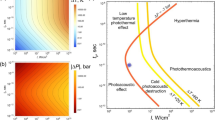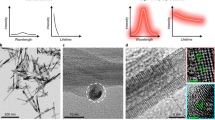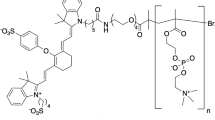Abstract
Photoacoustic imaging of living subjects offers higher spatial resolution and allows deeper tissues to be imaged compared with most optical imaging techniques1,2,3,4,5,6,7. As many diseases do not exhibit a natural photoacoustic contrast, especially in their early stages, it is necessary to administer a photoacoustic contrast agent. A number of contrast agents for photoacoustic imaging have been suggested previously8,9,10,11,12,13,14,15, but most were not shown to target a diseased site in living subjects. Here we show that single-walled carbon nanotubes conjugated with cyclic Arg-Gly-Asp (RGD) peptides can be used as a contrast agent for photoacoustic imaging of tumours. Intravenous administration of these targeted nanotubes to mice bearing tumours showed eight times greater photoacoustic signal in the tumour than mice injected with non-targeted nanotubes. These results were verified ex vivo using Raman microscopy. Photoacoustic imaging of targeted single-walled carbon nanotubes may contribute to non-invasive cancer imaging and monitoring of nanotherapeutics in living subjects16.
This is a preview of subscription content, access via your institution
Access options
Subscribe to this journal
Receive 12 print issues and online access
$259.00 per year
only $21.58 per issue
Buy this article
- Purchase on Springer Link
- Instant access to full article PDF
Prices may be subject to local taxes which are calculated during checkout





Similar content being viewed by others
References
Xu, M. H. & Wang, L. H. V. Photoacoustic imaging in biomedicine. Rev. Sci. Instrum. 77, 041101 (2006).
Oh, J. T. et al. Three-dimensional imaging of skin melanoma in vivo by dual-wavelength photoacoustic microscopy. J. Biomed. Opt. 11, 34032 (2006).
Zhang, H. F., Maslov, K., Stoica, G. & Wang, L. V. Imaging acute thermal burns by photoacoustic microscopy. J. Biomed. Opt. 11, 054033 (2006).
Wang, X., Xie, X., Ku, G., Wang, L. V. & Stoica, G. Noninvasive imaging of haemoglobin concentration and oxygenation in the rat brain using high-resolution photoacoustic tomography. J. Biomed. Opt. 11, 024015 (2006).
Zhang, H. F., Maslov, K., Stoica, G. & Wang, L. V. Functional photoacoustic microscopy for high-resolution and noninvasive in vivo imaging. Nat. Biotechnol. 24, 848–851 (2006).
Manohar, S. et al. Initial results of in vivo non-invasive cancer imaging in the human breast using near-infrared photoacoustics. Opt. Express 15, 12277–12285 (2007).
Ermilov, S. et al. Detection and noninvasive diagnostics of breast cancer with 2-colour laser optoacoustic imaging system. Proc. SPIE 6437, 643703 (2007).
Eghtedari, M. et al. High sensitivity of in vivo detection of gold nanorods using a laser optoacoustic imaging system. Nano Lett. 7, 1914–1918 (2007).
Li, P. C. et al. Photoacoustic imaging of multiple targets using gold nanorods. IEEE Trans. Ultrason. Ferroelectr. Freq. Control 54, 1642–1647 (2007).
Kim, G. et al. Indocyanine-green-embedded PEBBLEs as a contrast agent for photoacoustic imaging. J. Biomed. Opt. 12, 044020 (2007).
Yang, X., Skrabalak, S. E., Li, Z. Y., Xia, Y. & Wang, L. V. Photoacoustic tomography of a rat cerebral cortex in vivo with Au nanocages as an optical contrast agent. Nano Lett. 7, 3798–3802 (2007).
Zharov, V. P. et al. Photoacoustic flow cytometry: principle and application for real-time detection of circulating single nanoparticles, pathogens and contrast dyes in vivo. J. Biomed. Opt. 12, 051503 (2007).
Li, M.-L. et al. Simultaneous molecular and hypoxia imaging of brain tumours in vivo using spectroscopic photoacoustic tomography. Proc. IEEE 96, 481–489 (2008).
Wei, C.-W. et al. In vivo photoacoustic imaging with multiple selective targeting using bioconjugated gold nanorods. Proc. SPIE 6856, 68560J (2008).
Kim, K. et al. In vivo imaging of inflammatory responses by photoacoustics using cell-targeted gold nanorods (GNR) as contrast agent. Proc. SPIE 6856, 68560H (2008).
Bianco, A., Kostarelos, K. & Prato, M. Applications of carbon nanotubes in drug delivery. Curr. Opin. Chem. Biol. 9, 674–679 (2005).
Liu, Z. et al. In vivo biodistribution and highly efficient tumour targeting of carbon nanotubes in mice. Nature Nanotech. 2, 47–52 (2007).
Mizejewski, G. J. Role of integrins in cancer: survey of expression patterns. Proc. Soc. Exp. Biol. Med. 222, 124–138 (1999).
Janssen, M. L. et al. Tumour targeting with radiolabelled alpha(v)beta(3) integrin binding peptides in a nude mouse model. Cancer Res. 62, 6146–6151 (2002).
Vaithilingam, S. et al. Ultrasonics Symposium, 2007, 2413–2416 (2007).
Weissleder, R. & Ntziachristos, V. Shedding light onto live molecular targets. Nature Med. 9, 123–128 (2003).
Keren, S., Gheysens, O., Levin, C. S. & Gambhir, S. S. A comparison between a time domain and continuous wave small animal optical imaging system. IEEE Trans. Med. Imaging 27, 58–63 (2008).
Cai, W. et al. Peptide-labelled near-infrared quantum dots for imaging tumour vasculature in living subjects. Nano Lett. 6, 669–676 (2006).
Schipper, M. L. et al. A pilot toxicology study of single-walled carbon nanotubes in a small sample of mice. Nature Nanotech. 3, 216–221 (2008).
Kam, N. W., O'Connell, M., Wisdom, J. A. & Dai, H. Carbon nanotubes as multifunctional biological transporters and near-infrared agents for selective cancer cell destruction. Proc. Natl Acad. Sci. USA 102, 11600–11605 (2005).
American National Standards Institute. American national standard for the safe use of lasers. ANSI Standard Z136.1–2000 (ANSI, New York, 2000).
Loening, A. M. & Gambhir, S. S. AMIDE: a free software tool for multimodality medical image analysis. Mol. Imaging 2, 131–137 (2003).
Acknowledgements
We would like to thank J. Rosenberg for the statistical analysis. This work was supported, in part, by National Cancer Institute (NCI) Center for Cancer Nanotechnology Excellence (CCNE) U54 (to S.S.G.) and NCI In-Vivo Cancer Molecular Imaging Center (ICMIC) P50 CA114747 (to S.S.G.).
Author information
Authors and Affiliations
Contributions
A.D. built the photoacoustic instrument, designed and performed the experiments and wrote the paper. C.Z. designed, performed and analysed the Raman experiments. S.K. built the photoacoustic instrument and designed the experiments. S.V. designed and built the photoacoustic instrument. S.B. performed the experiments and helped write the paper. Z.L. synthesized the single-walled carbon nanotube conjugates. J.L. performed the cell uptake studies. B.R.S. helped write the paper. T.M. and O.O. helped design the photoacoustic instrument. Z.C. helped perform the comparison to fluorescence imaging. X.C. provided the RGD peptides, performed the fluorescence imaging of QD-RGD conjugates and helped write the manuscript. H.D. was responsible for single-walled carbon nanotube conjugation synthesis. B.T.K. was responsible for building the photoacoustic instrument. S.S.G. was responsible for experimental design and wrote the paper.
Corresponding author
Supplementary information
Rights and permissions
About this article
Cite this article
De La Zerda, A., Zavaleta, C., Keren, S. et al. Carbon nanotubes as photoacoustic molecular imaging agents in living mice. Nature Nanotech 3, 557–562 (2008). https://doi.org/10.1038/nnano.2008.231
Received:
Accepted:
Published:
Issue Date:
DOI: https://doi.org/10.1038/nnano.2008.231
This article is cited by
-
Current and Developing Lymphatic Imaging Approaches for Elucidation of Functional Mechanisms and Disease Progression
Molecular Imaging and Biology (2024)
-
Molecular and functional imaging in cancer-targeted therapy: current applications and future directions
Signal Transduction and Targeted Therapy (2023)
-
Bio-distribution of Carbon Nanoparticles Studied by Photoacoustic Measurements
Nanoscale Research Letters (2022)
-
A photoacoustic patch for three-dimensional imaging of hemoglobin and core temperature
Nature Communications (2022)
-
A hydrogen sulphide-responsive and depleting nanoplatform for cancer photodynamic therapy
Nature Communications (2022)



